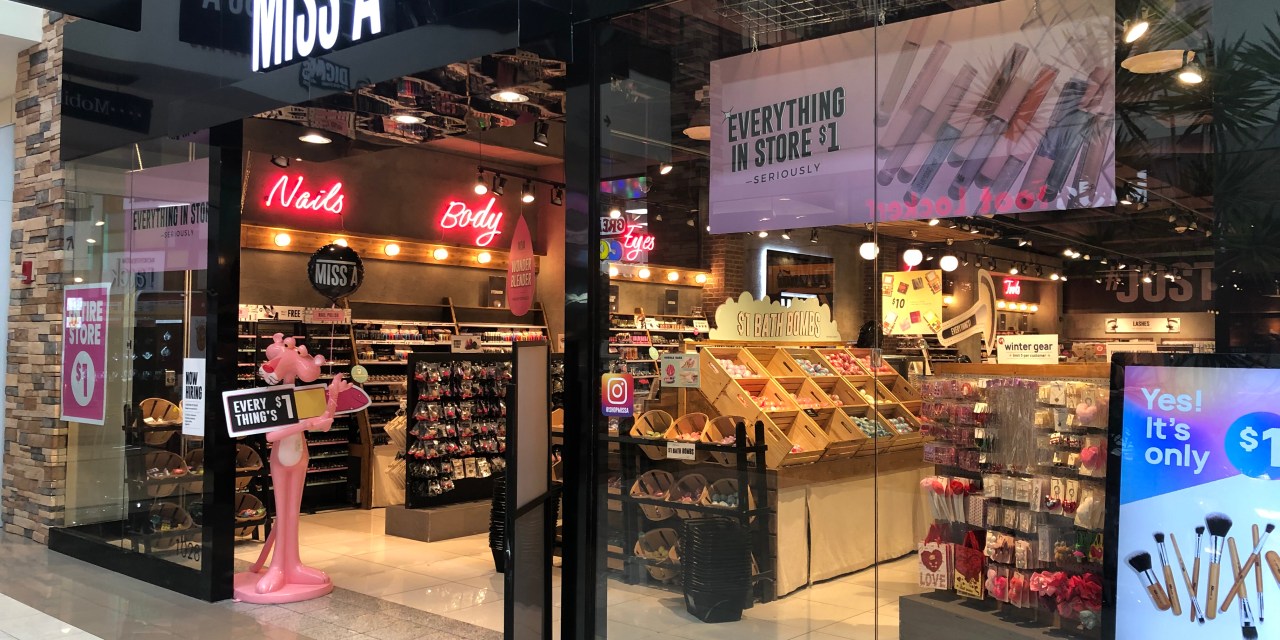Inside Miss A’s plan to expand its retail footprint

After 10 years of business, DTC brand Miss A is ready to bring its $1 beauty products to more physical spaces.
Miss A — which sells makeup, nail products and fake eyelashes, among others at a low price point — currently has 26 brick-and-mortar stores in the southwest region. By 2025, the company plans to grow its store count to 100. The company also plans to open 20 to 30 locations, in markets like Georgia and Florida, every year until 2025.
The company has remained entirely self-funded since its inception in 2013, which made executives cautious about investing heavily in physical stores early on. But when the company opened its first physical store in 2016, the results exceeded expectations. Now, physical stores have taken up a little over 50% of Miss A’s total sales, with its e-commerce sales making up the other half.
“I have no outside investment into the brand so obviously we have to take it slow,” said Jean Baik, founder and CMO of Miss A’s parent company Baik Brands, Inc. “Any money that we were making in the business, we were reinvesting into opening new stores and marketing.”
Many of Miss A’s products are priced at around $1 to $1.88. Higher priced items such as its 10-piece brush set and 6-Pack fake eyelashes are priced at 10.55 and $7.18, respectively. Miss A has a total of 10,000 SKUs, which are mostly from its AOA-owned brand.
In 2017, Miss A began setting up its retail expansion plan with a goal of opening around three stores a year. The company began by opening physical stores in different cities in Texas, such as Dallas, Houston, San Antonio and Austin. The pandemic shutdown forced Miss A to pause its expansion but sales quickly rebounded to pre-Covid levels in 2021. On average, physical store sales grow 10% to 20% year-over-year, while e-commerce grew about 5% pre-Covid.
Miss A currently has stores in four states surrounding Texas and plans to look into entering markets that make sense logistically, like Nevada and Arizona. Baik said Miss A has to truck a large number of products to different stores because the company sells products at a high volume. It is looking at opportunities to expand to cities close to its trucking route.
Ad position: web_incontent_pos1
At the moment, Miss A is opening stores in malls with the idea that its low price point would trigger impulse purchases from people that pass by the stores. In the future, Miss A has its eyes on opening stores in power centers, where stores like Target and Homegoods are typically located. Its average store is about 3,000 square feet in size.
Having physical stores also drive traffic to Miss A’s e-commerce site. “Since opening the stores, we’ve also seen a really big synergy between e-commerce and offline,” Baik said. “Oklahoma, that wasn’t a big city where customers would shop on Miss A. But once we opened a store in Oklahoma, we saw more traffic coming from Oklahoma to our website.”
Rebekah Kondrat, founder of the consultancy firm Rekon Retail, said that value-based retailers have to drive more volume to make their physical stores profitable. Given the high price of marketing products online, she said opening physical stores could be a more effective way to boost sales.
However, she said that brands have to remain cautious when expanding their physical presence en mass as many have failed in the past. For example, Casper announced plans to open 200 stores back in 2018, but the effort had not made the business profitable. Scotch & Soda closed a number of U.S. stores this year, some of which were open for less than a year, because of their underperformance.
“When a brand says we’re gonna build a hundred stores, it doesn’t mean all hundred are going to perform like the first five,” she said. “That’s a misconception that they will often have.”
Ad position: web_incontent_pos2
Miss A’s Baik is optimistic about the company’s strategic direction. In addition to store, Miss A has been expanding to new categories, including skincare and lifestyle products.
“We’ve been doing this for 10 years, and I think we’re confident now that the Miss A business model works,” Baik said. “It’s relatable to everybody, people love our products and our sales show that.”

